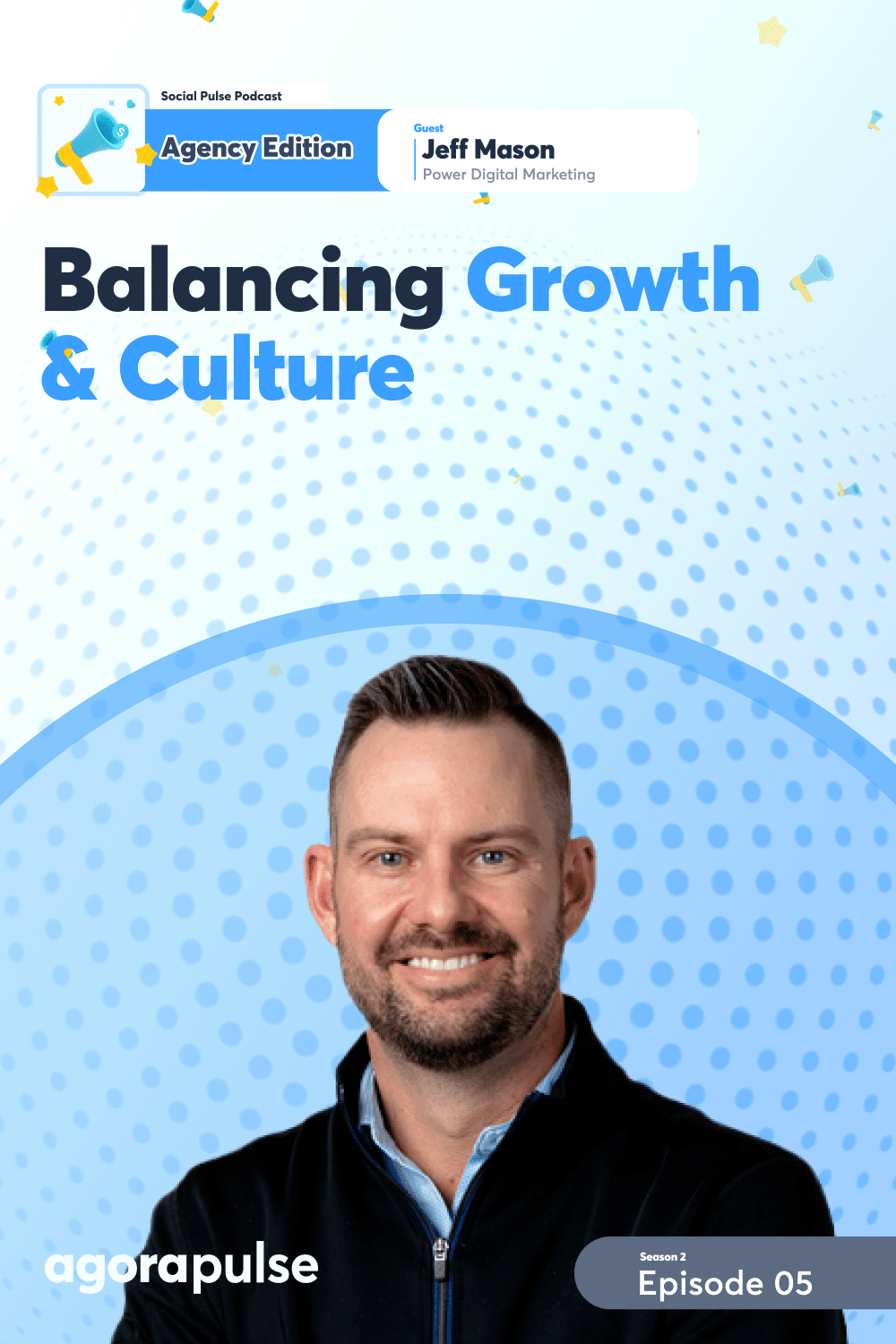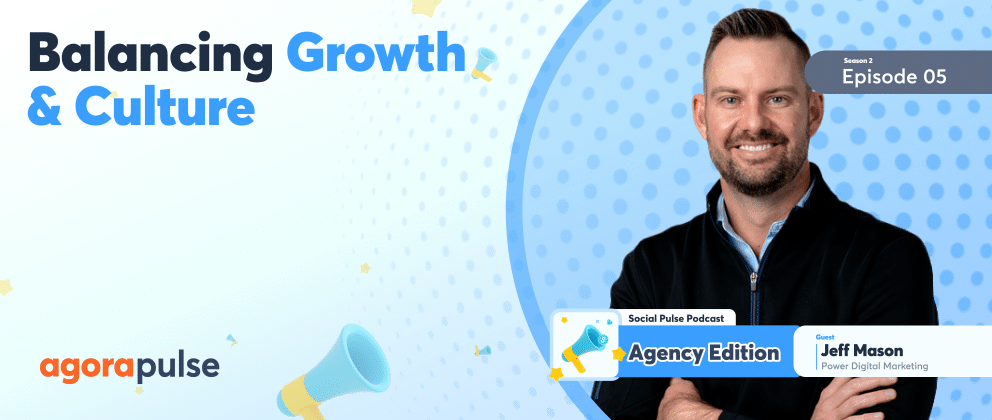What happens to marketing agencies and company culture when you suddenly add a hundred new employees? How do you keep that same strong sense of who you are as a brand?
Even when you’re acquiring another existing brand and all its employees and their existing ideas, a culture spinning a company through acquisitions is a terrific growth strategy—but it also presents a unique set of challenges, particularly when it comes to maintaining the core company culture that’s contributed to its success, balancing rapid growth with the preservation of company culture is no small feat, but it’s crucial for sustaining employee morale and retention.
Agorapulse’s Chief Storyteller Mike Allton sits down with Jeff Mason from Power Digital Marketing, a company known for its impressive 91 percent employee retention rate—despite undergoing five acquisitions in the past five years. Jeff shares how Power Digital has managed to integrate new teams, maintain its unique culture, and continue to thrive as it grows.
If you’re looking to expand your business without sacrificing the culture that makes it special, this episode is for you.
[Listen to the full episode below, or get the highlights of the Social Pulse: Agency Edition, powered by Agorapulse. Try it for free today.]
Mike Allton: So glad to have you.
Can you start by giving us an overview of Power Digital Marketing’s growth and the acquisitions I talked about that you’ve completed over the past few years?
Jeff Mason: I think it’d be a good place to start from the very beginning. Power Digital was founded in 2012 by our founder and chairman Grayson Lafrenz. He founded on the concept of democratizing and bringing transparency into what otherwise was more of a black box industry, which is more digital and performance marketing—what we now call growth marketing.
It’s a common problem, I think, a lot of brands face is demystifying what growth marketing is all about.
- What’s interesting is how Power Digital got started, it was actually a janitorial services company. I don’t think many people know this. It was that type of business, and we hired an SEO agency to help us with SEO.
- What we discovered was that the services that were being provided lacked value and transparency, and frankly, we had no idea how to measure the ROI.
- What we did was we hired our own SEO, and then we just decided to do our own SEO services in-house and then turn a profit or cost center into a profit center. And we started offering SEO services to other clients.
- That’s how we got into the marketing space and how Power Digital was born.
Fast forward nearly 12 years later: We’re a true full-service growth marketing company that drives value around growth, marketing through data, and helping the brands that we work with better understand their customer—which then in turn leads to developing refresh go-to-market strategies, new creative ideas, new messaging ideas, and then you layer a technology platform on top of it.
It drives a lot of value to a lot of consumer and B2B brands alike. But specifically over the last—call it four and a half—five years we’ve grown considerably in different areas.
Number one: Employee headcount has grown from a hundred to over 800 both domestically and internationally. And number two: We have 5X revenue both through organic and through acquisitions.
What we’re going to talk about today, specifically, [is] how we were able to keep our culture or even improve employee retention rate through those acquisitions.
Over a period of those five years, we did five employee-based acquisitions. And then we did one other, which was just a technology platform acquisition, but in collective well over 200 employees across those six acquisitions across both the U.S. and international locations.
How’d you keep retention and culture intact?
Jeff Mason: I think it starts with putting your money where your mouth is. What I mean by that is we spend 4 percent of our revenues on a dedicated organization inside Power Digital. Oftentimes it gets looked at as—or categorized as HR—and while we have HR compliance-related functions, we started an organization and called it the people organization, and we continue to invest up to 4 percent of our revenues into that organization.
And what it looks like are people who are dedicated to spreading culture, managing culture, and ensuring that we’re installing skills, career paths, and even personal and professional goals across the entire organization.
But I think oftentimes companies tend not to invest the dollar figure into it, but we’ve definitely learned over time and have a historical 91 percent retention rate. And this year it’s gone north and 95 percent of that is some of the best ROI you can get because in a people-based business, in a services-based business, the most important asset that you have is your people.
“If you’re not continuing to figure out ways to grow their skills, invest in their career, show them a career path, and also ensure that that career path matches their personal goals, then you’re not developing world-class products.
In a people-based business, your people are your product, and you have to continue to develop that product and make it world-class.”
Specific Strategies
Mike Allton: So talk to me about this people initiative that you guys started.
What were some of the specific strategies employed to help preserve that company culture during and after these acquisitions?
Jeff Mason: I think a couple of things that we do:
- When you are evaluating a potential acquisition, the first and most important thing that you can evaluate pre and post-diligence is core value alignment. And so you have your own company-defined core values. We have eight of them, and then we have one non-negotiable core value [that is] absolutely non-negotiable, and that’s a growth mindset.
- When you’re evaluating a potential acquisition that is probably the most important criterion, we’ve looked at hundreds of different opportunities to acquire different companies—and that is a non-negotiable in core value alignment. If you lead with that due diligence, everything else falls into place because, I mean, obviously, there are other things that you want to consider besides core values, and it’s got to be better for the employees. Not only the current employees at Power Digital but whoever the company target is that we’re looking to acquire. It’s got to be better for both employees—and then it’s got to be better for the clients.
- Evaluating whether or not the service that you’re bringing in and the services that you’re bringing into the other company form like this one plus one equals three types of mentality of value for clients. You have to consider that. And then you got to ensure that you have and develop a stronger product, which leads to eventually this kind of cross-sell upsell mentality.
Now, when you’re evaluating those types of criteria, the list of what you’re looking for becomes smaller and smaller. When you have an M&A strategy, you have to develop a list that becomes very, very small that you want to look at because it’s a lot of energy that goes into diligence and integration, but coming back full circle, the most important criteria is company culture, core value alignment—and our number one non-negotiable is a growth mindset.
Company Culture Clashes
Mike Allton: Knowing that about hires and assuming that about acquisitions, even though you do all that due diligence, I’m sure there have been some issues where there were some … clashes, let’s say, when it comes to culture:
How did you navigate clashes?
Jeff Mason: One example would be an acquisition we did that included international team members. And when you do an international acquisition, it’s two types of cultures that you’re integrating:
- The company culture
- The regional culture
And that in itself requires a different level of effort to overcome both those cultural dynamics.
Part of what we were able to do was ensure that key leadership team members on the acquisition target that we were integrating have a seat at the table when it comes to making integration decisions—especially when it comes to the regional and cultural elements that otherwise are sometimes difficult to define during diligence.
Having that leadership team and a company—let’s just say of 100 employees—they could have a leadership team of about 15 to 20 people making sure they have a seat at the table, and they feel bought into the plan means all the difference when it comes to integration because they’ll own a lot of the integration pieces.
They’ll also carry the message of why it’s important. The importance of what we’re doing and why integration is so important in that regard. But it’s the leadership team internally, myself, our MNA team, and our extended leadership team to engulf ourselves in that regional culture.
- For example, we had some team members in Latin America that are part of this acquisition. A handful of us took Spanish classes and did some of the initial onboarding meetings in as best Spanish as we possibly can offer up—but nonetheless it carried a valuable message to the team that we are investing just as much of our time, energy, and effort into wanting them to be successful and educating ourselves on their culture that it brought down this barrier, this awkwardness that you sometimes can have with integration, and they appreciated that.
Doing those things with intent, being very transparent, and giving people a seat at the table helps break down those challenges but otherwise could be very difficult.
Biggest Challenges with Company Culture
What have been some of the biggest challenges that you’ve faced with integrating new teams, and how did you overcome them?
Jeff Mason: I think part of some of the biggest challenges we run into is blending strategy and process and then translating the strategy and process on both sides of the house. Because if you think about merging two companies, they’ve been doing things the way that they’ve been doing them for as long as they’ve been in business.
When you bring them together, there’s a lot of translation that needs to happen. And part of what we do upfront in our diligence is a lot of that work, a lot of that co-authorization, if you will, to understand how deal flow works in an organization, to understand how their HR process works, to understand how their sales team operates, to understand how the delivery team operates.
And then we start putting translation protocols in place way up front. So we know what challenges might pop up as a result of translating those two things. I think oftentimes a lot of that work isn’t done up front and it’s done just in time. And so what ends up happening is a very rocky and discovery-type process during the integration, which doesn’t vote over wells for either side, especially the team members that are onboarding.
Want to level up your agency? Listen and/or read brand new episodes of Social Pulse: Agency Edition.
They want a very seamless integration process. I think it’s incredibly important to do that work up front, but then immediately start building bonds and relationships. I think you know relationships and bonds you can make with people are the currency that helps you get to that next level of trust and transparency, which was one of our biggest core values.
And so building those relationships early and often in the process is incredibly important. But I would say that the last piece is ensuring you have patience. No, I think earlier on in the first couple of acquisitions that we did, we tried to fast-forward the integration.
Mostly because we wanted to get the synergies. We wanted to get the revenue synergies, the cost synergies. And we try to push fast and get it done as fast as possible. The reality is to give yourself enough runway to ensure that it’s done right. Because again, in a services-based business, where people are delivering the services, the most important need is to protect those people and translate that and give that enough time.
I would say it’s often much more beneficial in the long term than it is trying to force it down very, very quickly, and have the integration just get off on the wrong foot.
Now other than learning new languages, how do you ensure effective communication between teams during these kinds of acquisition and integration processes?
Jeff Mason: Your communication conduits need to be wide open and occur very, very frequently. And so we do weekly cadence meetings. But if you think about weekly cadence meetings, you have an integration team cadence meeting, but then you have all the department heads that are integrating doing weekly cadence meetings.
What that allows you to do is A. measure progress but B. fish out any challenges that might have surfaced over the last week, over the last two weeks, or the last month that you can be proactively inclined to get ahead of. So that’s number one.
I think number two is setting a desired outcome. Out of every initiative you have as part of the integration: What is the KPI? What are we trying to solve here? Why are we bringing these teams together? Why are we trying to integrate this aspect of the business? What’s the expected benefit and what problem are we trying to solve? Oftentimes it may not be the best move, even though on paper, it looks good to integrate two different departments. It might be good just to wait and see how those things play out. How, you know, one department operates independently from another.
I think when you have that time to observe, you can better understand where the integration points are and not ruffle too many feathers when doing so.
Fostering Unifying Company Culture
Mike Allton: Now I do want to go back to that point about relationships because I’m wondering if there is anything that you’re doing, any specific practices or activities that you have in place that are helping to foster those relationships, foster a sense of unity, maybe even a sense of belonging among employees.
Jeff Mason: I think two things come to mind.
- Since COVID hit, we’ve artificially transitioned to a virtual world and no matter how many virtual meetings you run, Zoom meetings, Google Hangouts meetings, it can never take the place of physical connection with people. And so I remember our most recent acquisition and this one also had international components to it before we even closed on the transaction. We flew a team of 10 people down to Latin America where they had an office with about 60 people in the office and we conducted a town hall before the transaction even closed. And when we got to that office and answered all the questions that they had, I think it built this sense of trust and transparency and also comfortability, because there are so many questions that pop up during integration, and during an acquisition, most of the employees that are part of the acquisition that are coming into the company that’s buying them in this case, Power Digital have never gone through something like this and they have all these questions bouncing around in their mind and so giving them the conduit to ask those questions and to be there physically just to put the physical body and the voice and the personality in real life it speaks volumes and it does so much and I think in my mind, it’s kind of lazy when you don’t do things like this, especially because the world’s opened up to the physical world again, we can get in front of people on a day to day basis.
- But I think what we’ve done well is post-integration. We have a series of office hours and then we have a series of coffee chats. And so for instance, our executive team of 15 people, we’ll do coffee chats with individual team members. So I’ll do 10 and our chief strategy officer will do a handful of them and so on. We’ll just build relationships with as many of the team members as we can at the highest levels of leadership. And what that does is number one, humanize the company, but at the same time, number two, it fishes out any additional questions that otherwise might not be asked in a public environment that are just bouncing around in their mind. And again, leads back to transparency. It leads back to trust and it answers the questions that they have, which I think is so important when you’re doing an integration.
Mike Allton: Do you also have in-person retreats and that sort of thing, just ongoing for teams and departments?
Jeff Mason: Yeah. And we have—as I said—we invest 4 percent of our total revenues into the people organization. And so each department across power digital has a percentage of that money to do their own cultural events.
Then we have a company culture budget to do the same exact thing, but each department has complete autonomy in how they want to spend that culture budget. And, again, they do it quarterly. So it gets allotted every single quarter. And so when we think about how we drive company culture and then microculture departmentally, and one of our core values is autonomy giving leadership and departments, the autonomy to develop their own microcultures is incredibly important. And so some like to do in-person events. Some people like to do activities that are related to the interests of the team. Some people like to do skillset development. That’s on top of what we do, and we install it on a regular basis.
So giving them the freedom and the autonomy to develop their own microculture but at the same time, have it stemming from the top-level company culture. So the way we just empower the team members to spend some of that culture budget and drive the relationship that is the commercial aspect of culture overall.
How do you know if it’s working? How do you measure the success of those kinds of initiatives? Are there specific metrics? Are there feedback mechanisms? What do you guys use?
Jeff Mason: There are what we call lagging indicators and leading indicators.
Lagging. So lagging indicator of culture and the initiatives around culture will always be your team member retention. And so if team member retention on a quarterly, semi-annual, annual, and TTM basis stays consistent or gets better, usually means you’re doing something right. And if you look at our historical team member retention rate being 91 percent and right now it’s 95%, we continue to invest to ensure that we have that type of team member retention.
Leading. I would say some of the leading indicators are number one, we use a software application called 15 five. Each team member across Power Digital fills this out weekly. It takes five minutes. It measures bandwidth and measures sentiment. It’s feedback on their weekly goals, and it’s a way to facilitate communication between the manager and the team members. And we look at that data every single week. I have a CEO report that trends, bandwidth, and sentiment, and any team members that have had consistent weeks at a sentiment below seven or a bandwidth that’s called higher than eight. It’s we take proactive measures at the leadership level at the department level to ensure that we’re having those conversations with team members to figure out why their sentiment is dipping and what’s going on with their bandwidth.
Are they overworked? Are they burnt out? Do they need additional skills and do they need additional support? So that’s called a leading indicator. And then we also use monthly and quarterly what we call retention rate targets or KPIs, right? Leading back to our employee retention rate, but also departmental retention rates. So we look at all of those metrics.
And then lastly, we do something very interesting that we picked up from our first private equity firm, which is what’s called a Monthly Operating Review. And so what we do is we do people, talent, monthly operating reviews department by department, in which case the department leadership team puts together a people-based review. It’s a document that we spend an hour discussing with the leadership team to evaluate how people are doing, how is the overall sentiment, how are their skills developing, what career aspirations they have, our rising stars that we need to continue to fuel, are there people that we need to coach up?
We make intentional efforts to have conversations around people at different intervals, specifically in this meeting.
[And also sign up for Agorapulse for FREE today to get ahead.]
Final Words of Wisdom
Do you have any final advice or any words of wisdom for other companies who are thinking about growing through acquisitions and their concern about maintaining their culture?
Jeff Mason: Listen upfront in your diligence process is great as a company looks on paper, numbers-wise, growth, trajectory-wise product-wise, if there’s not a cultural fit at the leadership level. And it doesn’t ripple to the rest of the employees of that company.
Then it doesn’t matter how great their product is, how great their run rate is, or how great their growth is. It’s not a company that you should invest in because it’ll be oil and vinegar. What will end up happening is it’ll sacrifice your results, and it’ll distract you because the integration will be very, very difficult. It will also distract that company that you’re now trying to integrate and their growth will suffer, their product will suffer and their people will suffer.
No matter what it looks like on paper, get into the components of their core values.
I would highly encourage you to develop a non-negotiable with your company. Like, ours is a growth mindset. What is that one non-negotiable? You either have it or you don’t. And if you don’t, it doesn’t matter. (And by the way, we use that negotiable not only for acquisition targets, but for all of our hiring as well.) We have a one-and-a-half percent hiring rate at Power Digital because we test so hard for core values in the one non-negotiable.
And so if you haven’t developed that one non-negotiable, I highly encourage you to do that and then evaluate it up upfront early in the diligence process, and narrow down that list. When you find the right company and those core values match, do the rest of your diligence. I think what you’ll find is you’ll land great ones.
Your culture will get better. Your results will get better, and you’ll get exactly what you want out of the acquisition, which is growth.
Thank you for reading about how agency company culture and brand expansion in this latest episode of Social Pulse Podcast: Agency Edition on Apple, powered by Agorapulse, where each and every week we’re talking to marketing agencies like you going through many of the same struggles you’re going through and sharing their stories, subscribe to find in each episode, inspiration, motivation, and the perspiration that go into growing and scaling agencies like yours. Then leave us a review. We’d love to know what you think.
Until next time!






